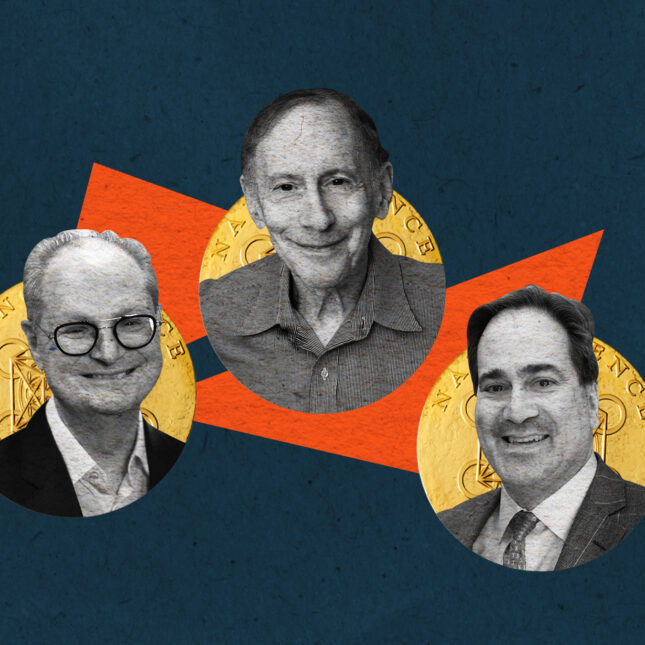
Three scientists — Robert Langer, Paul Alivisatos, and Chad Mirkin — were awarded the 2024 Kavli nanoscience prize for their seminal work in biomedicine, the Norwegian Academy of Sciences and Letters announced Wednesday.
The $1 million Kavli Prize recognizes scientists for significant contributions and breakthroughs in astrophysics, nanoscience, and neuroscience once every two years. Of the 65 laureates awarded the prize since 2008, 10 have gone on to receive the Nobel Prize.
The laureates’ work collectively revolutionized medical treatment on the nanoscale — with applications from therapeutics and vaccines to bioimaging and diagnostics. “Their work underscores the immense potential of nanoscience to shape our understanding and improve our lives in profound ways,” Lise Øvreås, president of the Norwegian Academy of Science and Letters, wrote of the laureates.
Serial entrepreneur Langer — he co-founded Moderna, and launched another new biotech just this week — is a prolific scientist, with upwards of 415,000 citations and 1,400 articles to his name. The Kavli award centered on his work to improve drug delivery.
As a postdoctoral researcher, Langer created a delivery system that controlled the release of drugs with a polymer carrier. The idea, and even Langer’s results, were met with skepticism. In 1976, Langer and his postdoctoral mentor Judah Folkman showed how his drug delivery system could be used to slow the growth of tumors. But he didn’t stop there.
By scaling down the polymer carriers to the nanoscale, they could sneak drugs into more tissues — but the unstable delivery systems often fell apart or were destroyed by the body before they reached their target. So Langer manipulated the nanoparticle complexes so they could stay intact for hours, allowing for highly controlled release of their drugs.
Following his breakthrough, Langer said his work took a number of directions — synthesizing new materials, changing the timing of release, and applying the technology to vaccines. “And then I had other ideas, too, that weren’t just drug delivery — I had ideas on drug removal, ideas on cell delivery,” he said.
Langer has nearly 1,500 patents licensed or sublicensed to more than 400 pharmaceutical and biotech companies. Companies like Alkermes utilize Langer’s nanotech in the form of “injectable microspheres” to treat type 2 diabetes, schizophrenia, and more.
Langer said when he first joined Folkman at Boston Children’s Hospital, he was the only engineer — it was unheard of for chemical engineers to do postdoctoral work in a surgical oncologist’s lab.
“It’s worth taking risks — I think it’s worth getting the rejection, and I think that it’s worth trying to to shoot for things that will really make a difference,” Langer said. “That’s a lesson that I learned for me, but it’s what I try to impart to my students too.”
Physical chemist Alivisatos, the current president of the University of Chicago, was recognized for his application of “quantum dots” in medicine. These nanoparticles absorb and emit light at a wavelength dependent on their size, powering many television and computer displays. Discovered in 1980, quantum dots were confined to those technological applications until Alivisatos came along. He found out how to make them compatible with living systems by enclosing the quantum dots in a silica shell, making them stable and soluble in water.
Now, quantum dots can be used as fluorescent markers to help biomedical researchers study cells, and even to deliver therapies. In photodynamic therapy for cancer treatment, for example, light emitted by quantum dots can activate drugs to induce the death of cancerous cells.
Chad Mirkin, a chemist at Northwestern University, pioneered the construction of spherical nucleic acids, or SNAs — a Koosh ball-like collection of synthetic DNA or RNA strands bound to a nanoparticle core. Mirkin discovered that SNAs could be used as diagnostic tools, detecting extracellular DNA signatures, proteins, and other molecules that indicate the presence of disease.
Later on, Mirkin had his eye on building SNA diagnostics that would work inside cells. But nucleic acids and cells, both negatively charged, repelled each other. Getting the SNAs inside proved impossible without toxic transfection agents.
Mirkin said it took his team over a decade to find a workaround. Finally, they found that SNAs could enter cells with the help of transport vessels called endosomes. With that kind of access, they could also be used for treatments: SNAs have been found to enter brain tumors, regulate cancerous gene expression, and slow tumor growth.
“Sometimes it’s good just to buck conventional wisdom and just out of curiosity, say, ‘What happens?’” Mirkin said.
Most recently, the Mirkin lab expanded even further, delving into SNA-based cancer immunotherapy and Covid-19 vaccines during the height of the pandemic.
“It wasn’t good enough for us just to do the science,” Mirkin said. “Let’s make scientific discoveries, but let’s connect the dots and ask how we use those discoveries to create new technologies that improve the world.”
To submit a correction request, please visit our Contact Us page.











STAT encourages you to share your voice. We welcome your commentary, criticism, and expertise on our subscriber-only platform, STAT+ Connect